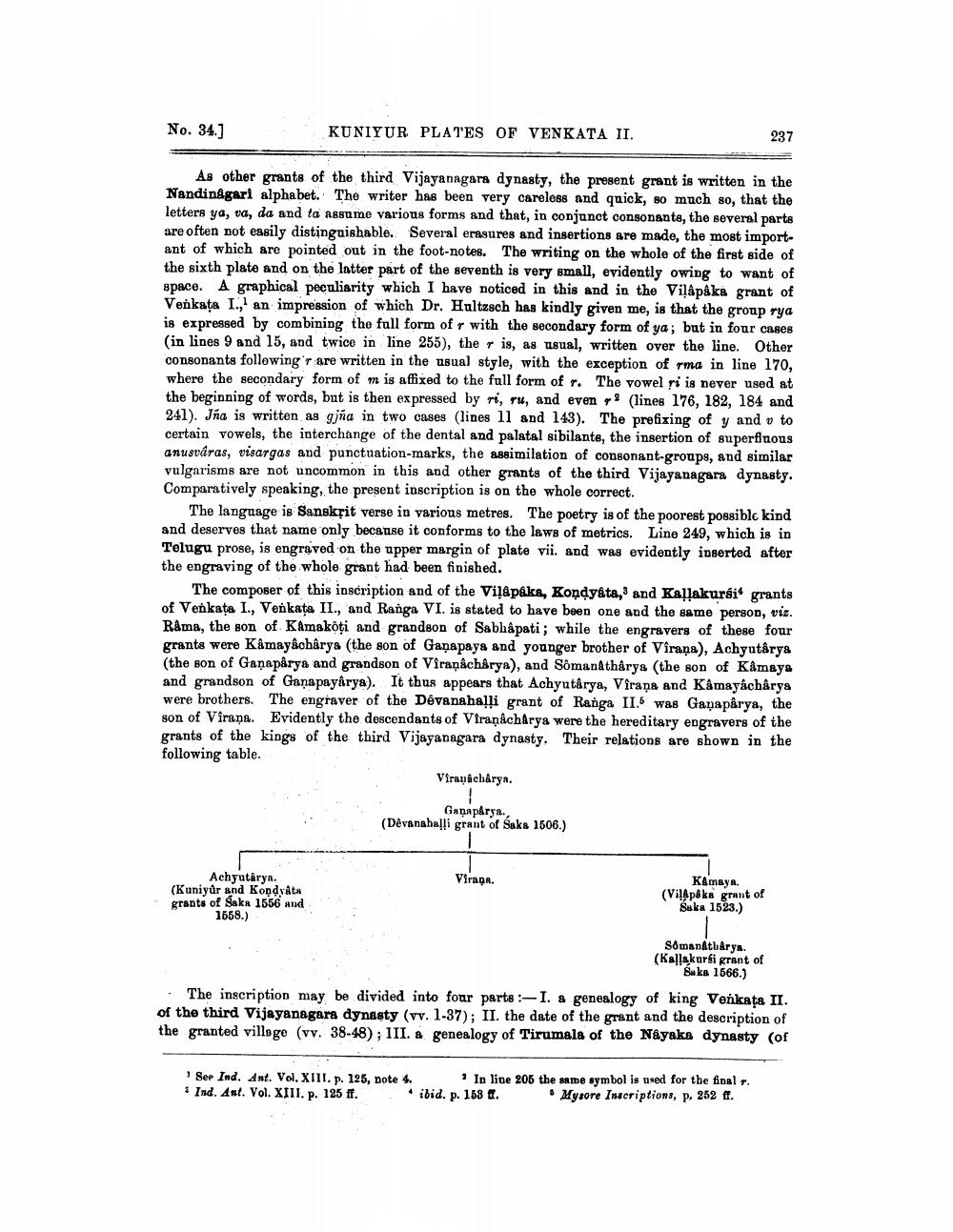________________
No. 34.]
KUNIYUR PLATES OF VENKATA II.
237
As other grants of the third Vijayanagara dynasty, the present grant is written in the Nandingari alphabet. The writer has been very careless and quick, so much so, that the letters ya, va, da and ta assume various forms and that, in conjunct consonants, the several parts are often not easily distinguishable. Several erasures and insertions are made, the most important of which are pointed out in the foot-notes. The writing on the whole of the first side of the sixth plate and on the latter part of the seventh is very small, evidently owing to want of space. A graphical peculiarity which I have noticed in this and in the Vilápåka grant of Venkata I., an impression of which Dr. Haltzsch has kindly given me, is that the group rya is expressed by combining the fall form of r with the secondary form of ya; but in four cases (in lines 9 and 15, and twice in line 255), the is, as usual, written over the line. Other consonants following are written in the usual style, with the exception of rma in line 170, where the secondary form of m is affixed to the full form of r. The vowel ri is never used at the beginning of words, but is then expressed by ri, ru, and even * (lines 176, 182, 184 and 241). Jña is written as gjña in two cases (lines 11 and 143). The prefixing of y and v to certain vowels, the interchange of the dental and palatal sibilants, the insertion of superfluous anusváras, visargas and punctuation-marks, the assimilation of consonant-groups, and similar vulgarisms are not uncommon in this and other grants of the third Vijayanagara dynasty. Comparatively speaking, the present inscription is on the whole correct.
The language is Sansksit verse in varions metres. The poetry is of the poorest possible kind and deserves that name only because it conforms to the laws of metrios. Line 249, which is in Telugu prose, is engraved on the upper margin of plate vii. and was evidently inserted after the engraving of the whole grant had been finished.
The composer of this inscription and of the Viļápáka, Kondy&ta,' and Kallakursit grants of Venkata I., Venkata II., and Ranga VI. is stated to have been one and the same person, viz. Rama, the son of Kamakoti and grandson of Sabh&pati; while the engravers of these four grants were Kåmayacharya (the son of Ganapaya and younger brother of Virana), Achyutarya (the son of Ganapârya and grandson of Viraņâcharya), and Sómanáthârya (the son of Kåmaya and grandson of Ganapayårya). It thus appears that Achyutârya, Vîrana and Kamayachârya were brothers. The engraver of the Devanahalli grant of Ranga II. was Ganaparya, the son of Virana. Evidently the descendants of Viraņácharya were the hereditary engravers of the grants of the kings of the third Vijayanagara dynasty. Their relations are shown in the following table.
Virayacharya.
Ganaparsa. (Devanahalli grant of Saks 1606.)
Virаря.
Achyutarya. (Kuniyûr and Kopdyta grants of Saka 1556 and
1658.)
KAmaya. (Vilepska grant of
Saka 1523.)
Soman&th Arya. (Kallakursi grant of
Saks 1566.)
• The inscription may be divided into four parts - I. a genealogy of king Venkata II. of the third Vijayanagara dynasty (vv. 1-37); II. the date of the grant and the description of the granted village (vv. 38-48); III. a genealogy of Tirumala of the Nayaka dynasty (of
Ser Ind. Ant. Vol. XIII. p. 125, note 4. * Ind. Ant. Vol. XIII. p. 125 ff.
- In line 205 the same symbol is used for the final . ibid. p. 158. Mysore Inscriptions, p. 252 ff.




